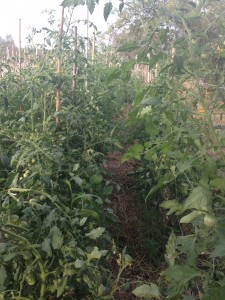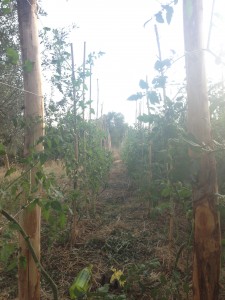Now that the garden manager, Marco, is back, I’ve had someone to work with more regularly and learn a lot about vegetable production. While Casa Caponetti was more focused on expanding its restaurant and B&B in the last couple years, they are hoping to increase production in the vegetable garden this fall in order to sell at a market in Rome. Since the growing season in this area is quite long, we have been doing a lot of transplanting and starting new seeds. I’ve also learned how to prune tomatoes (some were very overgrown) so that they have enough room to grow without becoming overcrowded, creating too much humidity. We’ve planted peppers in the same rows as the tomatoes where there is extra space or a missing plant.
We are also starting a lot of seedlings for zucchini, fennel, green beans, and cucumbers. The seeds are started in soil blocks, which are made with a tool that sort of stamps out containers of potting soil into small square chunks. It gets really hot here during the day, so the seedlings are covered and kept in the shade until they sprout. Once leaves come up, we have to make sure they constantly get enough water until they’re planted in the ground.
When I’m not in the garden, I have also been working on an independent research project to test the effectiveness of a particular type of homemade olive fruit fly trap. Olive fruit flies (Bactrocera oleae) devastated the olive harvest for much of Europe in 2014. They oviposit into the olives as they are ripening, and the larvae hatch and live off of the fruit until they emerge as flies in the fall. The trap I’m examining was developed at an organic olive orchard in Spain and is called the OLIPE (short for Olivarera de los Pedroches) trap. It is made by melting holes around the neck of a plastic 1.5 L bottle and filling it with a solution of 1 L water and 3 Torula yeast tablets. These traps are known to work particularly well for combatting the olive fruit fly, but unfortunately I seem to have come at the wrong time of year to successfully test their effectiveness. The conditions have not been as favorable for the pest this year as they were in 2014, which is great for olive farmers, but a bit of a struggle for my research project. I have been having a hard time identifying them and am not sure if I have caught any at all yet. Luckily the garden manager would be able to continue collecting data for me after I leave, so I’ll see how things go in the next couple weeks. Wish me luck!




